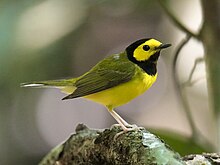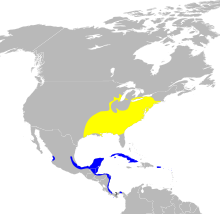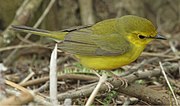Hooded warbler
| Hooded warbler | |
|---|---|

| |
| Adult male | |
| Scientific classification | |
| Domain: | Eukaryota |
| Kingdom: | Animalia |
| Phylum: | Chordata |
| Class: | Aves |
| Order: | Passeriformes |
| Family: | Parulidae |
| Genus: | Setophaga |
| Species: | S. citrina
|
| Binomial name | |
| Setophaga citrina (Boddaert, 1783)
| |

| |
| Range of S. citrina (note: missing distribution on Hispaniola) Breeding range Wintering range
| |
| Synonyms | |
|
Wilsonia citrina | |
The hooded warbler (Setophaga citrina) is a New World warbler. It breeds in eastern North America across the eastern United States and into southernmost Canada (Ontario). It is migratory, wintering in Central America and the West Indies. Hooded warblers are very rare vagrants to western Europe.
Recent genetic research has suggested that the
Taxonomy
The French polymath
The hooded warbler was formerly placed in the genus
Description

The hooded warbler is a small bird and mid-sized warbler, measuring 13 cm (5.1 in) in length and weighing 9–12 g (0.32–0.42 oz).
Life history
These birds feed on
Gallery
References
- . Retrieved 12 November 2021.
- PMID 20696258.
- S2CID 13691956.
- ^ "Family Parulidae". IOC World Bird List.
- ^ Buffon, Georges-Louis Leclerc de (1779). "Le gobe-mouche citrin de la Louisiane". Histoire Naturelle des Oiseaux (in French). Vol. 8. Paris: De L'Imprimerie Royale. p. 336.
- Daubenton, Louis-Jean-Marie (1765–1783). "Gobe-mouche, de la Louisiane". Planches Enluminées D'Histoire Naturelle. Vol. 7. Paris: De L'Imprimerie Royale. Plate 666 Fig. 2.
- ^ Boddaert, Pieter (1783). Table des planches enluminéez d'histoire naturelle de M. D'Aubenton : avec les denominations de M.M. de Buffon, Brisson, Edwards, Linnaeus et Latham, precedé d'une notice des principaux ouvrages zoologiques enluminés (in French). Utrecht. p. 41, Number 666 Fig. 2.
- ^ Paynter, Raymond A. Jr, ed. (1968). Check-list of Birds of the World. Vol. 14. Cambridge, Massachusetts: Museum of Comparative Zoology. p. 50.
- ^ PMID 20696258.
- ^ a b Gill, Frank; Donsker, David, eds. (2019). "New World warblers, mitrospingid tanagers". IOC World Bird List Version 9.2. International Ornithologists' Union. Retrieved 10 September 2019.
- .
- ISBN 978-1-4081-2501-4.
- ^ a b "Hooded Warbler". All About Birds. Cornell Lab of Ornithology.
- ^ "Hooded Warbler Identification, All About Birds, Cornell Lab of Ornithology". www.allaboutbirds.org. Retrieved 2020-09-30.
- Wilson Bulletin. 10 (5): 70.
External links
- Hooded warbler species account – Cornell Lab of Ornithology
- Hooded warbler – Wilsonia citrina – USGS Patuxent Bird Identification InfoCenter
- Stamps[usurped] (for Cuba, Saint Vincent and the Grenadines) with Range Map at bird-stamps.org
- "Hooded warbler media". Internet Bird Collection.
- Hooded warbler photo gallery at VIREO (Drexel University)
- Hooded warbler bird sound at Florida Museum of Natural History
- Hooded warbler species account at Neotropical Birds (Cornell Lab of Ornithology)




